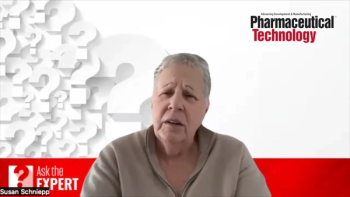
- BioPharm International May 2025
- Volume 38
- Issue 4
- Pages: 12–13
Automation Advances for Cell Harvesting in Biomanufacturing
Although automation is increasingly adopted in biomanufacturing, challenges remain in implementing it at the cell harvesting step.
Cell harvesting is an important step in the manufacture of biologic modalities, and one area where automation technologies can play a major role. Traditionally, cell harvesting has relied heavily on centrifugation and depth filtration, both labor-intensive techniques that are prone to variability. But recent advances in automation technologies have significantly improved the efficiency, scalability, and consistency of cell harvesting to enable more streamlined bioprocessing workflows.
Some notable advancements
Among the most notable developments is the integration of single-use systems with automated depth filtration and tangential flow filtration (TFF) platforms. These systems minimize manual interventions and contamination risks while providing real-time data monitoring and control. Such technologies allow for scalable, closed-loop processing with pre-validated filtration schemes, which enhances process robustness and reduced turnaround times (1).
Microfluidics is also emerging as a promising alternative, especially for small-scale and high-throughput settings. Automated microfluidic platforms can sort and separate cells based on size and deformability with high precision. While not yet widely adopted in large-scale manufacturing, the potential for integrating these platforms into modular production facilities is gaining interest (2).
Despite advancements, the biopharmaceutical industry continues to show variable rates of adoption of automated cell harvesting technologies. Legacy facilities often continue to rely on centrifugation, largely due to capital investments needed to transition to automated systems as well as regulatory familiarity using traditional methods. The growing push for continuous processing, flexible manufacturing, and digital integration is, however, accelerating the adoption of automation in other stages of the biomanufacturing cycle.
Regulatory agencies including FDA and the European Medicines Agency have shown support for these innovations in automated and advanced manufacturing technologies through initiatives such as FDA’s Emerging Technology Program, which encourages early engagement with developers to assess novel manufacturing technologies (3). Widespread adoption of these technologies still faces barriers, however.
In speaking with Erica Johansson, head of Down Stream Processing, and Agnes Zimmer, PhD, head of Process Development, both at Sweden-based NorthX Biologics, a contract development and manufacturing organization, BioPharm International® discussed the ins and outs of automated cell harvesting in use to date.
Cell harvesting status
BioPharm: How much of the cell harvesting step is automated today?
Johansson (NorthX Biologics): It is important to automate where there is a clear benefit of doing it. Depending on what kind of manufacturing is performed (early clinical or late clinical/commercial), the automation level of cell harvest differs.
When working with production of material for Phase I/II studies, the cell harvest is often performed using centrifugation, tangential flow filtration, and/or depth filtration (i.e., standalone units). Although cell harvest is performed with automated systems, a lot of manual interventions are necessary since the process is still being developed.
Zimmer (NorthX Biologics): When working with commercial production, still, standalone units are often used for the cell harvest, but much less manual interventions are necessary since the process has been established. To retain the flexibility needed for early phase production with not fully established manufacturing processes, it is key to keep the level of automation at an appropriate level allowing manual interventions and flexibility.
Investing too early in extensive automation adds cost and time to projects where the final outcome is uncertain. That implies that the level of automation should follow the maturation of the product and the true benefits in control and efficiency comes when scale and number of batches increase.
Pros and cons
BioPharm: What have been the pros and cons of automated cell harvesting
Zimmer (NorthX Biologics): The advantage of using automated cell harvesting is of course the possibility to perform the step similar between different batches, not depending on who is running the step. Furthermore, more data will be available after each finished run to use for evaluation of the process. Since less manual interventions are necessary, automation decreases staffing demands.
Johansson (NorthX Biologics): The drawback with automated cell harvest is the handling and qualification that is necessary for computerized systems, for example, when using a TFF system. When working with new products the information about the process is limited making it difficult to set all the parameters needed to set a method. Even though [one is] using an automated system for cell harvesting, several test runs are often needed before the production can start as all parameters necessary for the system need to be defined/verified. Furthermore, purchasing costs may be significantly higher when working with automated systems compared to manual set-ups.
Key technologies and approaches
BioPharm: What key technologies or innovations have enabled the automation of the cell harvesting process?
Johansson (NorthX Biologics): The already mentioned [TFF] and disc stack centrifugation are commonly used as technologies for clarification and can indeed be seen as the industry workhorses. In addition to these techniques, ATFs [alternating tangential flows], continuous centrifugation, and acoustic cell separation could enable efficient and continuous clarification for perfusion processes.
Zimmer (NorthX Biologics): In certain cases, the development of high-capacity depth filtration has been proven as a valuable tool with comparably low technical complexity. Control systems such as PLCs [programmable logic controllers] and SCADAs [supervisory control and data acquisitions] with feedback loops from advanced sensors are of course crucial for the operation of automated systems.
BioPharm: Are there particular approaches, techniques, or equipment that have pushed cell harvesting optimization forward?
Zimmer (NorthX Biologics): The development of automated TFF systems and continuous centrifuges have contributed to the automation of the cell harvesting process. When using TFF, several unit operations can be performed in one single step [i.e., separation of cells, removal of medium, and concentration of the product solution]. This is very beneficial for an optimized and cost-effective production. Furthermore, automated filtration and continuous centrifugation enable time-efficient processing at large scale.
Cell harvesting in the future
BioPharm: What is the future of cell harvesting and what role will new technologies/methodologies play in shaping biomanufacturing?
Johansson (NorthX Biologics): Depending on [whether one is] working with batch or perfusion cultivation, continuous bioprocessing could be applicable. When working with perfusion cultivation and the product is expressed in the media, continuous harvest can be performed. The implementation of continuous processing solutions enabling a fast process bioreactor culture to formulated drug substance incorporating both cell harvest and chromatography is an interesting area where progress is expected to be seen.
References
1. Lindskog, E., et al. Advances in Single-Use Technologies for Biopharmaceutical Manufacturing. Biotechnol. Prog. 2020, 36 (2), e2925.
2. Kim, H. S.; Devarenneb, T. P.; Han, A. A High-Throughput Microfluidic Single-Cell Screening Platform Capable of Selective Cell Extraction. Lab on a Chip 2015, 11.
3. FDA. Emerging Technology Program (ETP). fda.gov (accessed April 14, 2025).
About the author
Feliza Mirasol is science editor at BioPharm International®.
Article details
BioPharm International®
Vol. 38, No. 4
May 2025
Pages: 12–13
Citation
When referring to this article, please cite it as Mirasol, F. Automation Advances for Cell Harvesting in Biomanufacturing. BioPharm International 2025, 38 (4), 12–13.
Articles in this issue
8 months ago
The Challenge of Market Uptake for Biosimilars8 months ago
Complying with European versus US GMPsNewsletter
Stay at the forefront of biopharmaceutical innovation—subscribe to BioPharm International for expert insights on drug development, manufacturing, compliance, and more.




